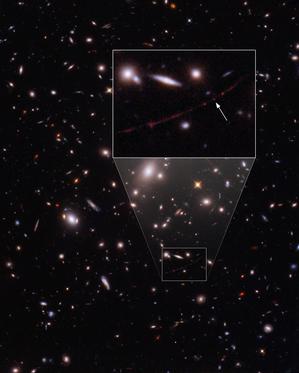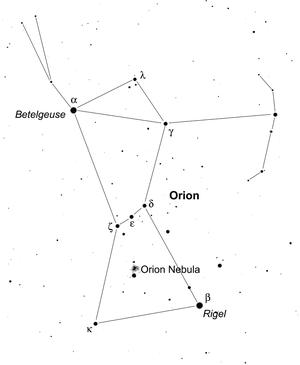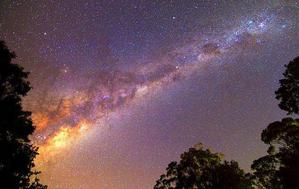Glossary term: Star
Description: A star is a ball of plasma – atomic nuclei separated from their electrons – that is held together by its own gravity, and prevented from collapse by inner pressure that is the consequence of nuclear fusion processes in the star's core regions. Astronomers, in a slight abuse of physical terminology, commonly use "gas" and "plasma" interchangeably, and hence also refer to stars as balls of gas. In the atmosphere of a star the plasma may only be partially ionized and (depending on the temperature of the star) even contain some atoms.
The star closest to Earth is the Sun.
In a more general sense, the word "star" is taken to include protostars where nuclear fusion has not yet begun, and stellar remnants such as neutron stars or white dwarfs, which are two possibilities (depending on mass) for what stars turn into once they have exhausted the fuel for their nuclear fusion. Such stellar remnants are not simply plasma balls – a white dwarf can crystallize into an unusual kind of solid after cooling down for billions of years, and neutron stars bear a close similarity to gigantic atomic nuclei.
Whether viewed with the naked eye or with visible-light telescopes, stars are the most obvious objects in the night sky. In the cosmos, they are typically found within galaxies, each star generally accompanied by one or more planets. The study of how stars form and evolve is an important subfield of astrophysics.
Related Terms:
See this term in other languages
Term and definition status: This term and its definition have been approved by a research astronomer and a teacher
The OAE Multilingual Glossary is a project of the IAU Office of Astronomy for Education (OAE) in collaboration with the IAU Office of Astronomy Outreach (OAO). The terms and definitions were chosen, written and reviewed by a collective effort from the OAE, the OAE Centers and Nodes, the OAE National Astronomy Education Coordinators (NAECs) and other volunteers. You can find a full list of credits here. All glossary terms and their definitions are released under a Creative Commons CC BY-4.0 license and should be credited to "IAU OAE".
Related Media
A gravitational lens magnifies one of the first stars
Credit: NASA, ESA, B. Welch (JHU), D. Coe (STScI), A. Pagan (STScI) credit link
License: CC-BY-4.0 Creative Commons Attribution 4.0 International (CC BY 4.0) icons
Watchtower and Paddy Fields Under the Starry Sky
Credit: Likai Lin/IAU OAE
License: CC-BY-4.0 Creative Commons Attribution 4.0 International (CC BY 4.0) icons
Related Activities
What is a Constellation?
astroEDU educational activity (links to astroEDU website) Description: Investigate three dimensional objects and perspective using constellationsLicense: CC-BY-4.0 Creative Commons Attribution 4.0 International (CC BY 4.0) icons
Tags: Hands-on Age Ranges: 6-8 , 8-10 Education Level: Primary Areas of Learning: Modelling , Social Research Costs: Medium Cost Duration: 1 hour 30 mins Group Size: Group Skills: Analysing and interpreting data , Asking questions , Constructing explanations , Developing and using modelsStar in a Box: Advanced
astroEDU educational activity (links to astroEDU website) Description: Explore the life-cycle of stars with Star in a Box activity.License: CC-BY-4.0 Creative Commons Attribution 4.0 International (CC BY 4.0) icons
Tags: Hands-on , Interactive , Software Age Ranges: 10-12 , 12-14 , 14-16 , 16-19 Education Level: Middle School Areas of Learning: Technology-based Costs: Low Cost Group Size: Group Skills: Communicating information , Constructing explanationsStar in a Box: High School
astroEDU educational activity (links to astroEDU website) Description: Explore the life-cycle of stars with Star in a Box activity.License: CC-BY-4.0 Creative Commons Attribution 4.0 International (CC BY 4.0) icons
Tags: Hands-on , Interactive , Software Age Ranges: 10-12 , 12-14 , 14-16 , 16-19 Education Level: Middle School Areas of Learning: Technology-based Costs: Low Cost Group Size: Group Skills: Communicating information , Constructing explanationsStar Hats
astroEDU educational activity (links to astroEDU website) Description: Make your star hat, learning about the starsLicense: CC-BY-4.0 Creative Commons Attribution 4.0 International (CC BY 4.0) icons
Tags: Art , Creativity , Hands-on Age Ranges: 4-6 Education Level: Pre-school Areas of Learning: Fine Art focussed , Interactive Lecture Costs: Low Cost Duration: 30 mins Group Size: Individual Skills: Asking questions , Communicating informationHow Light Pollution Affects the Stars: Magnitude Readers
astroEDU educational activity (links to astroEDU website) Description: Build a Magnitude Reader to explore the magnitude of stars.License: CC-BY-4.0 Creative Commons Attribution 4.0 International (CC BY 4.0) icons
Tags: Hands-on , Dark skies , ecology Age Ranges: 10-12 , 12-14 , 14-16 , 16-19 Education Level: Middle School Areas of Learning: Modelling , Observation based Costs: Medium Cost Duration: 1 hour Group Size: Group Skills: Asking questions , Planning and carrying out investigationsStreet Lights as Standard Candles
astroEDU educational activity (links to astroEDU website) Description: Understand astronomical distances using street lightsLicense: CC-BY-4.0 Creative Commons Attribution 4.0 International (CC BY 4.0) icons
Tags: Hands-on , Distances , Distance measurements , Inverse square law Age Ranges: 14-16 , 16-19 , 19+ Education Level: Informal , Secondary , University Areas of Learning: Modelling , Structured-inquiry learning , Technology-based Costs: Low Cost Duration: 3 hours Group Size: Group Skills: Analysing and interpreting data , Constructing explanations , Developing and using models , Planning and carrying out investigations , Using mathematics and computational thinkingLiving in the Milky Way
astroEDU educational activity (links to astroEDU website) Description: Build a model of the Milky Way to discover what our galaxy contains.License: CC-BY-4.0 Creative Commons Attribution 4.0 International (CC BY 4.0) icons
Tags: Hands-on , Model Age Ranges: 6-8 , 8-10 Education Level: Primary Areas of Learning: Problem-solving , Social Research Costs: Medium Cost Duration: 1 hour 30 mins Group Size: Group Skills: Asking questions , Communicating information , Developing and using models















